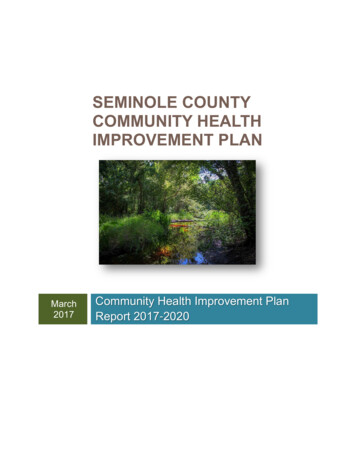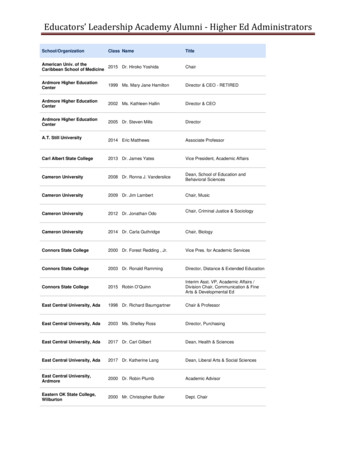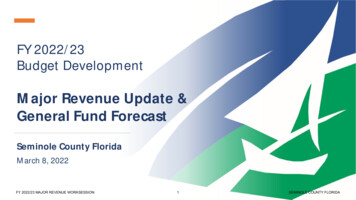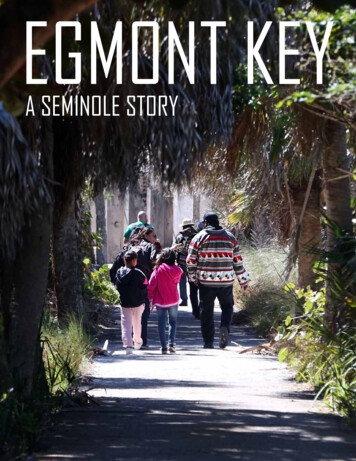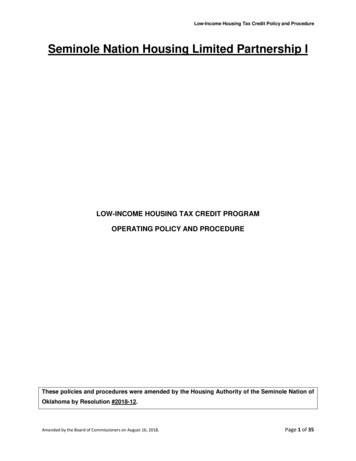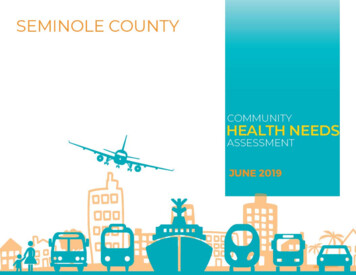
Transcription
SEMINOLE COUNTY
TABLE OFCONTENTSBACKGROUNDAcknowledgementsLetter to the Comm!XlityCLINICAL CARE03Access to Care3404Injury & Hospitalizations3636Birth CharacteristicsMETHODOLOGYHEALTHSeminole CountyOSSeminole County Overview06Economic Conditions38About this ReportPrimary & Secondary Data10School & Student CharacteristicsSafety404112COMMUNITY PROFILE2019COMMUNITYHEALTH NEEDSASSESSMENTSOCIAL & ECONOMIC FACTORSIntroduction & MethodologyPHYSICAL ENVIRONMENTCommunity Profil e14Demographics15Physical Environment42POLICIES AND PROGRAMSHEALTH OUTCOMESLength of Life16Leading Causes of Death17Quality of Life Indicators18Chronic Disease Indicators18Mental Health Indicators20Community Input Top County Health ls.sues22Key Changes Since Last CHA24HEALTH BEHAVIORSTobacco UseDiet & Exercise2829Alcohol & Drug Use32Sexual Activity33Priority Areas44APPENDIXSources and ReferencesA
ACKNOWLEDGMENTSThe, Florid., De,p,:1rtrnent of Health in "'lerninole Cour1ty th.:1nk-:. the following individual'::, and or9 .:1niz .:1tions for their in\.,.,::tlu.,ble contributionsto this reportCHNA LEADERSHIP TEAMDATA COLLABORATIVE GROUPAdventHealthAspire Health PartnersOrlando HealthOrange Blossom Family Health ServicesOsceola Community Health ServicesTrue HealthFlorida Department of Health in Lake CountyFlorida Department of Health in Orange CountyFlorida Department of Health in Osceola CountyFOCUS GROUPS (10)Health and Hunger Task ForceFirst RespondersElder Adult ProvidersHomelessness PrwidersMental Health ProvidersAdventHealth Care CenterSen1inole County Correctional Facility - Fen1ale PopulationSen1inole County Correctional Facility - Male PopulationHealthy Sen1inole Con1munity Health PartnersAspire Health PartnersSTAKEHOLDER INTERVIEWS (18)Central Florida YMCAAspire Health PartnersHealth Council of East Central FloridaMetro PlanSecond Harvest Food Bank of Central FloridaCentral Florida Con1mission on HomelessnessFlorida Department of Children and Families - Regional DirectorFlorida Department of Children and Families - Substance AbuseMental Health Association of Central FloridaTrue HealthSeminole County EMSShepherd's HopeBoys and Girls Club of Central FloridaFlorida Department of Children and Families - Refugee ServicesFlorida Department of Children and Families - Human TraffickingFlorida Department of Children and Families - Adult ServicesFlorida Department of Children and Families - Foster Care
LETTERTO THE COMMUNITYThe Florida Department of Health in Seminole County is pleased to onceagain be part o f a collaborative effort w ith local hospitals. surro und ing countyhealth departments and other stakeho lders and community partners tode,,elop a com prehensive Community Health Needs Assessment (CHNA).The health of a community is often measured by the physical. m ental andsocial well being of the people w ho Liv e there. It is becoming commonlyunderstood that factors Like our socioecono mic status. education. physicalenv ironment. employment. social supports. and access to care all play a partin shaping o ur health and quaLity of Life.Health data that is collected and analyzed through the Community HealthNeeds Assessment is used to identify these and other key health ind icato rsthat help us address the significant health issues affecting our communitiesand focus on opportunities for imprwement.These assessm ents have led to find ings of hig h rates of cardiovasculardisease. diabetes and obesity. as well as food insecurities and access tohealth care c hallenges in our community. w hich have allowed us to developinitiatives suc h as farmer's markets. access to food pantries and mobile healthservices to reduce health d isparities and improve health outcomes.The Florida Department of Health in Seminole County. along w ith our partnersand stakeholders. is committed to prom oting healthy communities w here welive. work. learn and play. and improving the quaLity of Life for everyone byprovid ing equal opportunities to achieve optimal health and wellness.We at the Florida Department of Health in Seminole County would Like tothank Orlando Health. Advent Health. Aspire Health Partners. True Health.Orange Blossom Family Health Center. Osceola Community Health Servicesand the health departments of Osceola. Lake and Orange counties for theirv isio n and partne rship in provid ing this valuable service to our communities.PAGE 4Donna J. Walsh. MPA. BSN. RNHealth OfficerFlorida Departme nt of Health in Semino le County
INTRODUCTIONThe Florida Department o f Health in Semino le County (DOH-Semino le) produces a Community Health Needs Assessm ent (CHNA) every threeyears. The CHNA tells the story of public health in Seminole County. It shares the wonderful things about our community and the ways w ecan improve. W e all have a role to play in making Seminole County a healthier place to live, learn, work and play! As you read the CHNA.think about how you can becom e involv ed.METHODOLOGYTo dev elop the CHNA. we used the Mobilizing for Action through Planning and Partnerships (MAPP) model. The MAPP model ismade up of four assessments that help identify public health issues in our community:Community Health Status Assessment I This explains the health standing of our community Between September 2018 and June2019. the assessment helped us identify our key community health problems by rev iew ing data about health conditions. quality oflife and risk factors in the communityCommunity Themes and Strengths Assessment I Information was collected between October 2018 and May 2019 from 10 focusgroups. 14 individual stakeholder interviews and 623 community survey participants. 9 intercept survey participants and 83 keyinformant survey partic ipants This data helped us learn w hat issues are important to our community. how the quality of life is seenin our community and w hat resources our community has that can be used to improve health.Local Public Health System Assessment I The local public health system (LPHSA) is a process for evaluating and documentinghow well the local public health system is organized. governed. and fulfills the essential services of public health. The FloridaDepartment of Health in Seminole County facilitated the assessment in June 2019 to discover opportunities for improving theperformance of the system by collaborating w ith community partners. Facts and figures were collected from four public healthsystem scoring groups Thi s data helped us learn how well public health services are being provided to our community and theperformance and abilities of our community health system. To read the complete LPHSA v isit http://seminole floridahealth gavForces of Change Assessment I Information was collected from community leaders. w hich helped us learn w hat is happening orcould happen that affects the health of our community and w hat dangers. or opportunities are exposed by these occurrences.On April 5. the DOH-Seminole Community Health Improvement team met w ith the county. collaborative andcommunity leadership team to review data and rate and rank prioritiesUsing this CHNA as a guide. we w ill create the Community Health Improvement Plan (CHIP) It w ill be used to improvehealth concerns reported in the CHNA. in partnership w ith a group of dedicated leaders from community organizations
SEMINOLE COUNTY OVERVIEWCOMMUNITY DEMOGRAPHICS AND HIGH RISK POPULATIONSAccording to Census Pop -Facts from Environics in 2019. over the next 5-year period. Seminole County is expected to grow byabout 64 %. from 4734 08 in 2019 to 503,576 in 2024. w hic h is slightly below the state of Florida's expected growth rate (6 8%)The community has slig htly more females (509%) than males (49 1%) The population is also predominantly W hite (74 9%) and hasa sizable Hispanic population (217%) W hile the Hispanic percentage is below that of the state of Florida (312%). it is higher thanthe nation averall (18 3%) The median age in 2019 is 40 2. slightly lower than the state of Florida overall (425) The median age isexpected to grow sLig htly older to 41 7 by 2023 The percentage of residents living in Seminole County w ith an education beyondhigh school (664 %) is substantially hig her than the state of Florida (493%). and nation (390%) The median household income is 66,494 w ith 8 7% of the families having incomes below the federal poverty level and 294 % of households having incom esunder 50.000 1Health is influenced by cond itions w here we live and the ability and means to access healthy food. education. affordable housing.and j obs The poverty rate in Seminole County in 2017 was 11.2%. W hile this is lower than the state rate of 14%. the rate increasedfrom 74 % in 2000. In Seminole County. the Sanford zip codes have both the hig hest paverty rates (bet ween 150% and 200%) aswellas the hig hest unem ployment rates (54 % and 52%) of the zip codes in the county. 2The largest health disparities in the four-county region are related to race. income and education. For exam ple in 2016 for behavioralrisk factors and disease incidence and 2017 for death rates. Blacks in Seminole County have the highest rate of colorectal cancer incidence (344 ) com pared to W hites (303) andHispanics (255)W hites have the highest rate of breast cancer incidence (1137) compared to Blacks (917) and Hispanics (752)W hites (483) also have the highest rate of lung cancer in Seminole County com pared to Blacks (44 0) and Hispanics (24 5)Blacks have the hig hest rates of asthma (136%) com pared to Hispanics (57%) and W hites (4 9%)Non-Hispanic Blacks (44 5) have the highest d iabetes death rates com pared to W hites (238). W hite Hispanics (195) and BlackHispanics (105)Infant mortality per 1.000 births in Seminole County is highest am ong Blacks (79) com pared to W hites (54 ) and Hispanics (61)Births to mothers w ith less than a high school education is highest among Hispanics (11 2%). compared to Blacks (71%) andW hites (5 9%)Ad ults w ith incomes less than 25k are more likely (17 1%) to have poor mental health compared to those w ith incomesbet ween 25k and 49k (73%) and those w ith incomes 5ok and abave (2 6%) 3PAG E 6
HEALTH ISSUES AMONG POPULATION GROUPS 4There are a variet y of health issues identified among specific population groups. although these specific needs and issues may notbe identified as one of the "top 10" issues w ithin each of the primary research methodologies In Seminole Count y. stakeholdersidentified Adverse Childhood Experiences (ACEs) and the impact of parental stress on a child as key community issues. Accordingto key informants. community issues faced by teens include: a lack of housing stability as well as a lack of access to nutritious foodand quality healthcare. There is also a lack of knOJVledge of oral hygiene and obesity among youthFocus group participants identified endocarditis (infection inside the heart as a result of IV drug use). Hepatitis C (due to needlesharing). and sexually transmitted diseases as top community issues related to communicable diseases. particularly among thosewho are IV drug users. Intercept survey respondents identify Hepatitis C and A IDS as top community health needs. Key informantsidentified HIV/AIDS as a top commun ity issue because a stigma still exists toward people who have HIV and there is a perceptionthat A IDS has been solved. The new HIV cases reported rate per 100.000 has been increasing in Seminole Count y over the pastfifteen years from 12.8 in 2008 to 173 in 20173Being obese or overweight is one of the most prevalent chronic conditions among Seminole County respondents to the 2018community survey. w ith over half (52 6%) indicating that it is a problem for them or a family member. Hypertension and high bloodpressure is almost nearly as prevalent at 51% Almost half of the respondents indicated that high cholesterol (48 1%) is also a problemfor them or someone in their familyAlmost a third of the Seminole Count y respondents (291%) to the community survey indicated that diabetes is a problem Heartdisease (265%). cardiovascular diseases (257%) and asthma/COPD (chronic obstructive pulmonary disease) (255%) affect abouta quarter of respondents' families. Cancer affects one in five families (206%) One in ten (93%) respondents indicated that strokeaffects them. A lmost one in ten (78%) indicated that childhood obesity is a problem they have experienced A higher percentage ofrespondents from Seminole Count y have experienced obesity/overweight (52 6%) when compared to the four-count y region overall(513%) A ll other chronic cond itions were lower or comparableFocus Group participants identified cancer (all t ypes). obesity. high blood pressure. high cholesterol. kidney disease. heart disease.stroke. diabetes. and asthma as top community health needs. Intercept survey respondents identified lack of transportationespecially for follOJV up appointments and health literacy among adults as key commun ity issues.Almost all of the key informants representing Seminole County (978%) indicated that mental health issues affect the clients theyserve. A lmost two-thirds (64 0%) of stakeholders indicated that mental health is a top community issue. w ith lack of mental healthproviders and corresponding services as a priority to be addressed. Focus group participants commented that people are notpaying enough attention to their OJVn mental health. Another concern is that individuals diagnosed w ith a mental health conditionmay be avermedicated
SOCIAL DETERMINANTS OF HEALTH AFFECTING SEMINOLE 4Almost a quarter of the community survey respondents in Seminole Count y (224%) had experienced the lack of affordable andadequate housing Seminole County had a smaller percentage of respondents experienc ing housing problems when comparedto the four-county region (252%) In the four-count y region overall. 91% of the Community survey respondents indicated that theywere worried about stable housing versus 45% in Seminole Count y Stakeholders indicated that lack of affordable housing andhomelessness were important economic issues.Focus group participants commented that people do not have access to food and shelter and those w ith lower income may nothave good health. Responses indicated there is a high population of individuals who are homeless. and the commun ity lacks acommon definition of homeless. There is also a lack of economic mobilityKey informant survey participants cited poverty. homeless adults and youth. lack of good paying jobs/jobs w ith advancementoptions. and lack of affordable housing as important community issues.Uninsured and underinsured residents delay seeking care until their illnesses are acute due to economic cond itions and access tocare barriers.Intercept survey participants identified lack of living wage jobs and lack of transportation as important community issues. Barriersinclude a lack of transportation. poverty. financial literacy. lack of livable wage jobs. criminal records and work (can't take time offwork to get care)Services needed identified by the primary research respondents include increased public transportation (routes and times).affordable quality housing. homeless support. shelters and job training There is a need for more job training and education. Trainingfor professionals when dealing w ith someone who is homeless or struggling would also be beneficial. Respondents indicated that itis important to educate young people on economics and to focus on financial planning and education for community residents.Key informants representing Seminole County commented that ACEs (Adverse Childhood Experiences) need to be taken intoaccount and that there are more behavioral and mental health care services needed for students. The stressors related to povertyand housing instability increase the need for mental health services.Barriers to care include the continued stigma associated w ith mental health issues as well as difficulty accessing mental healthservices. According to focus group participants. not all mental health professionals are welcoming or show compassion and respectto individuals who need help There is also a lack of self-awareness to recognize when someone has a mental health problem andpeople often do not know where to go for care.PAGE 8
Accord ing to the primary researc h participants. needed services included transportation. more com passionate providers available.reduced wait time for services. services in schools and more services for LGBTO . both youth and adults. There is also a need fortherapy services. an increased need for clinically sound biling ual care. as well as appropriate care for v ictims of natural disastersw ho are dealing w ith trauma. The community would also benefit from m ore treatment for substance abuse. more options for griefcounseling. and education on how to recognize w hen people need mental health services or support There is also a need for peersupport. mentoring and role modeling as well as education to reduce stigmaA slightly higher percentage of community survey respondents from Seminole County (141%) have experienced alcohol abusecom pared to the region overall (122%) Stakeholders stressed that substance use d isorder is a top community problem. Keyinformants indicated that there is a rise in vaping and e-c igarette use. The number of fentany l-related deaths in Seminole Countyincreased from 2 in 2011 (a rate of 04 8 per 100.000) to 36 in 2017 (778 per 100.000) The controlled substance prescribing rate forSeminole County per 1.000 population increased from 5733 in 2013 (249,973 pills) to 5927 in 2017 (274,222 pills) sAccord ing to the community survey participants. 187% of Seminole County respondents lack recreational opportunities. 195% lacksafe roads/sidewalks. 258% lack access to healthy high-quality affordable food and 6.6% lack access to fresh available d rinking waterStakeholders commented that there is insuffic ient access to healthy food and a lack of physica l activity opportunities in the county.There is also a lack of usable sidewalks.Focus group participants d iscussed that many residents have poor d iets and are not eating well. Food insecurity is a problem incertain areas. People are not physically active either. Key informants cited poor infrastructure. includ ing low quaLity housing. as keyissues in the county. They noted the numbers of individuals living in homes that are unfit for habitation. especially those w ith children.
HEALTH BEGINS WHERE YOULIVE, LEARN, WORK AND PLAY6All Semino le County residents sho uld have the opportunity to make the choices that allow the m to Liv e a lo ng. healthy Life. regardless of theirincome. education. ethnic backgro und or abiLities.It is important to work toward raising the bar for all Semino le County residents so that everyone can have the opportunity to make healthyc hoices.A disparity is w hen different g roups of people have very different levels of health for no obv ious reason. For example. it is importantto know if people in one part of our county are sicker than people in the rest of the county. We would want to figure out w hat is going on andidentify opportunities for better health.WHATDETERMINES OUR HEALTH?Economic Stability: emplayment. incom e. housing. affordabiLity of foodand other necessitiesEducation: high school graduation. language. literacySocial & Community Context: social support. discrimination. civic par ticipatio n. po Licies. cultureHealth & Health Care: access to health care. access to interventions.health literacy (or abiLity to understand and inte rpret health information)Neighborhood & Built Environment: pubLic safety. access to healthyfoods. quaLity o f housing. access to sidewalks. air quality. water quaLity.street lig hting. parks.1IPAGE 10
COUNTY HEALTH RANKINGS MODEL8Length of Life (50%)HEALTH IS MORE THAN HEALTH CAREHealth OutcomesQuality of Life (50%) -Health Behaviors(30%)Oinical Care(20%)Health Factors.Policies & Programs. -Tobacco UseI-Diet & Exercise Alcohol & Drug Use Sexual Activity-Access to Ca re Quality of Care-Education EmploymentSocia!&IncomeEconomk Factors(40%)PhysicalEnvirorvnent(10%).Family & Social Support.Community Safety.-Air & Water Quality .Health is more than w hat happens at the doctor's o ffice.As illustrated in the model at left a w ide range of factorsinfluence how long and how well we live. from education andincom e. to w hat we eat and ho,v we move. to the quality ofour housing and the safety of our neig hborhoods. For som epeople. the essential elements for a healthy life are readilyavailable: for others. the opportunities for healthy c hoices aresignificantly Limited.HEALTH IS FOR EVERYONEAcross the country there are significant differences in healthoutcomes. from o ne county to the next and among raciaVethnic groups. For example. Blacks. Native Americans andHispanics have consistently faced barriers to o pportunity andgood health. Health disparities emerge w he n some individualsgain m ore than others-fro m consistently better access tooppo rtunities and resources over the course of their Liv es.Increasing o pportunities for everyone can reduce gaps inhealth. For example. provid ing better access to hig h-qualityeducatio n and enrichment opportunities boosts workforceskills that are key to landing a good job and for upwardecono mic mobility.Housing & TransQ .;rh e Semino le County 2019 Community Healtli Needs Assessm e nt is o rg anized according to t lie t opics in the County Hea lth Rankings M odel. The dat a provides a snapsh o t o f the Health O utcom es,Health Fact ors and Po licies and Prog rams in Semino le County.
WHY DOES THE CHNA INCLUDE INFORMATION ON EDUCATION AND INCOME?Hig her education and incomes impact health in many ways. People w ith higher incomes have the opportunity to make healthy choices becausethey are more Likely to live in safe homes and neighborhoods. have access to healthy foods and safe places to exercise. have health insuranceand resources to deal w ith stressful life events. Those w ho are working and still struggLing to pay the rent can't always make healthy c hoicesbecause they don't have as many resources. Families w ho are struggling to get by are also more Likely to face mo re overall stress and have lessresources to deal w ith stressful events. Chronic stress c reates higher levels of harmful hormones. w hic h can inc rease the risk of many d iseasessuc h as cancer. diabetes. heart d isease and stroke.aSo. it makes sense that g roups of people w ith more education and hig her incom es generally have better health and Liv e longer than thosew ith lower incomes. Middle-incom e Americans are healthier than those w ho struggle financially . but they are less healthy than those w ith highincomes. Groups of people w ith the lowest incomes tend to have the worst health and d ie younger.8WHY ARE THE STATISTICS BROKEN DOWN BY POPULATION GROUPS?By comparing. we can see w here we are doing well and w here we could imprwe. It is helpful to look at how healthypeople in Seminole are. as a g roup. compared to people in the rest of Flo rida or in the w ho le United States. Thesecomparisons cannot be appLied to ind ivid ual peop le. only to groups of people. For exam ple. men might be twice asLikely to die of accidental poisoning than wom en. but that does not mean a specific man is twice as Likely to die frompoisoning than his sister. ffflTTnn,mr,,The graphic on the left shows theg roup of men have a 25% c hance ofbeing orange. not that one man has a25% c hance o f being orange. IW HAT ARE THE RATES? Rates are a way to compare between g roups of d ifferent sizes. Let's say 1.000 ice c reamcones were handed out at the county fair and 100 ice cream cones fell to the ground. 50 of the ice c ream coneswere strawberry ice c ream and 50 were mint c hocolate chip ice c ream . These numbers would make us think thatstrawberry and mint c hocolate chip ice c ream cones fall to the g round at the sam e rate. But. w hat if 80% of the icecream cones handed out were strawbe rry and 20% were mint c hocolate c hip? Then we would expect that if 100cones had fallen. So would be strawberry and 20 would be mint c hocolate chip. Rates help us see the number ofice c ream cones that fell in re lation to the number of ice c ream cones handed out.PAG E 12Ice Cream Cones Hande d OUt800 Strawberry200 Mint Chocolate Chip1,000 Total ConesI Ice Cream Cones that Fell50 Strawberry50 Mint Chocolate Chip100 Total ConesFall Rate50 of 800 6% (1 out of every 16)50 of 200 . 25% (1 out of every 4)100 of 1.000 . 10% (1 out of every 10)
"- ' ' ,'; This symbol Is used throughout theCHNA to hlghllght disparities. orareas that need Improvement. wefocus on the Issues that needImprovement so we can worktogether on solutions!
COMMU NITYPROFILEPOPULATION 1 503,576 2024GROWTH -6.37%2019-2024 ---EDUCATIONAL ATTAINMENT15.9%(19,83151.8% 148.2% Less Than High School Some College I Associate Degree PAGE 14High SchoolBachelor Degree or Above139,595186,565
POPULATION BY AGE 1e0-1415-24e25-54 55-64 65 Graphs are based on the 2019 total estimated population of 473,408.POPULATION BY RACE1HISPANIC POPULATION BY RACERACE/ETHNICITY 'White Alone280,793White. Hispanic87.330Black Aloni: 52.298Black, HiSpc 1iCe W hit e, A lone!Black. Alonee20186,734OtherAmerican Indian, Alone (0.3%)Asian Alone (4.516)Native Hawaiian/ Pacific Islander (0.08%)2 or M ore Races, Alone (3.6'6)Some Other Race, Alone (4.516)
fEAl Tt fOUTCOMESHealth Outmmes resent how.healthy.a ltl - -1&-Years o f potential life lost (YPLU or po tential years of Life lost (PYLUB. is an estimateof the average years a person would have lived if he or she had not died prematurely(before age 75). It is. therefore. a m easure of premature mortality. As an alte rnative todeath rates. it is a method that gives mo re weight to d eaths that occur among youngerpeoplePREMATURE DEATH9,000.06,750.05,702.94 ,500.03 682,250.00.0YEARS O FPOTENTIAL LIFELOST RATEYEARS OFPOTENTIAL LIFELOST (BLACK)YEARS O FPOTENTIAL LIFELOST (HISPA NIC)YEARS O FPOTENTIAL LIFELOST (WHITE)
PREMATUREMORTALITY 2018*Cardiov,3scular Disease.; is the leading c ause ofcle. tth in Seminole County Risk factors includingsmoking. high cholesterol. high blood r)ressure.r. hfsical in.;,ctr,ity .,net cli.;,betesNl!lmoel'i ofi DeatliisLEADING CAUSES OF DEATH*203.0CARDIOVASCULARDISEASES184.4Ag -Alt ii t Hl· Rates are 2018 per 100.000 RATORYDISEASES69.363.9OTHER CAUSES(RESIDUAL)EXTERNA LCAUSESPAGE 17
IHEALTHOUTCOMESWhite residents of SeminoleCounty (55.1) are more likely tod ie of a stroke than White Floridaresidents overall (38.8).3QUALITY OF LIFE10540FHI.UTn.lilNTlil&ST/NO PL5ASUR5:LACK COMPANIONSHIPDEPRESSEDMOPELESS50.5%FEEL ISOLATED COMMUNITY SURVEYRESPONDENTS85.30/oDIFFICULTY SLEEPINGEXPERIENCEDPAST2WEEKSCHRONIC D1SEASE3PreventableHospitalizationsUnder 65 fromCongestiveHeart Failure hasdecreased from2012 to 2017.(72.0-53.9)PAGE 18Age-AdjustedColorectalCancer Incidencehas decreasedfrom2012 to 2016(36.6-31.1)Age-AdjustedFemale BreastCancer Incidencehas increasedfrom2012 to 2016(110.3-114.2)Age-Adjustedlung CancerIncidence hasincreased from2012 to 2016(46.7-48.2)
"Chronic diseases are prevalent in thecommunity. They are affected by socialdetenninants like food and hausin:,. STUDENTS DIAGNOSED WITH ASTHMA3- Community stakeholder'9.400ADULTS DIAGNOSED WITH DIABETES35.0%8.7%11.2%1 1.8%200200720132016Heart Disease deaths have increasedin Sen1inole County 2.0%between 2011 (1377i an,j 2017(140 5),·\Yorr1en are rr,ore likely than men to experienc e··-;.ilenr· he.-rt .;\tacks. which have less ?gnizable symptoms like chest pain Thisrnav explain why fe.x.-er women sur, r1e their firsthe;rt att;ck th.-n men 9I
HEALTHOUTCOMES ACTSOCIAL & MENTAL HEALTH ft IIn Florida. n1ental illness is thenun1ber one disabling conditionthat leads to hornelessness.'2.ACTAdults -.r.;ith household incomeis undeirS50K 3r9 more li,.,ely to hJve depr,;iss 1edi orde-r than thosei ,,.;ith high,;;ir incomeis)ft Itra .,t-1t1,.:r 3Semino Count1 t"1ad t1·.e largest overallincreaS& for suicide rates in t1·,9 r ionforyour,g adults age 1!;r21from6.3 in 20U.1 to 24.0 in 20 17Jl in 10,.,,y,,"'!e·- a1 ARE CHILDRENft IPAGE 20Adults age 18-44 are more likelyto have depressive disorder thanother age groups'ARE WHITEHAVE A D ISABILITYARE MALE"While the "public face" of homelessness is often that of peopleexperiencing long-term chronic homelessness. the reality is that theexperience of homelessness spans demographics and populations -youngand old. employed and unemployed. healthy and ill. female and male.·12
Between 2012 and 2017,"Mental health is a top communityneed. Ithink that families we deal withbecome easily overwhelmed and don'tknow where to tum. Then they deferseffin:t treatment and Itgets worseand wor:se. .w upwltll a Cllflto thelwJJmeand geJ. involwd to he/pot#-tgt #(ifr!t,.v:ACTvCcr943FOSTEACMILDQEN/OO RA NGECO UNTY . . SEMINO LECO UNTYy OSCEO LA AaLAKECOUNTY278CO UNTY Om C"""""N 222" m '"Approximate foster children. each County (2017)1
HEALTHOUTCOMESCOMMUNITY INPUT OF TOP COUNTY HEALTH ISSUESCOMMUNITY SURVEYTOP ISSUES AFFECTING RESPONDENTS & FAMILIES'"ALLERGIESSTAKEHOLDER INTERVIEWSTOPlO PRIORITIES1302 HEALTH CARE COSTS/LACK OF INSURANCE/AFFORDABILITYHOMELESSNESS/ .AFFORDABLE HOUSINGA('(' c TOA F ( R )A8 E HE AL ( ARE'' .RA",SPURTA ON07 ,' (08PAGE 22DIABETES
COMMUNITY INPUT OF TOP COUNTY HEALTH ISSUESKEY INFORMANT SURVEYTOP COMMUNITY ISSUES14FOCUS GROUPTOP COMMUNITY ISSUES15r }( 07"iAVll,AT N(, HEHFAL T ( AQF c,yc TE ,1
HEALTHOUTCOMESKEY CHANGES SINCE 2016 COMMUNITY HEALTH NEEDS ASSESSMENT16COMMUNITYCHARACTERISTICSSCHOOL & STUDENTCHARACTERISTICS. PopulationGrowth. .MedianHouseholdIncome .FreeandReduced Lunch.Poverty.HomelessStudents. . nemploymentHigh SchoolGang Activity.JuvenileNewAIDS Case
and jobs The poverty rate in Seminole County in 2017 was 11.2%. While this is lower than the state rate of 14%. the rate increased from 74% in 2000. In Seminole County. the Sanford zip codes have both the highest paverty rates (between 150% and 200%) aswell as the highest unemployment rates (54% and 52%) of the zip codes in the county.
